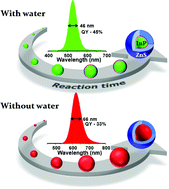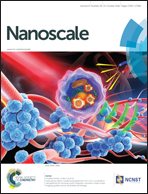Beneficial effects of water in the colloidal synthesis of InP/ZnS core–shell quantum dots for optoelectronic applications†
Abstract
We demonstrate that the presence of a small amount of water as an impurity during the hot-injection synthesis can significantly decrease the emission lines full width at half-maximum (FWHM) and improve the quantum yield (QY) of InP/ZnS quantum dots (QDs). By utilizing the water present in the indium precursor and solvent, we obtained InP/ZnS QDs emitting around 530 nm with a FWHM as narrow as 46 nm and a QY up to 45%. Without water, the synthesized QDs have emission around 625 nm with a FWHM of 66 nm and a QY of about 33%. Absorption spectra, XRD and XPS analyses revealed that when water is present, an amorphous phosphate layer is formed over the InP QDs and inhibits the QD growth. This amorphous layer favors the formation of a very thick ZnS shell by decreasing the lattice mismatch between the InP core and the ZnS shell. We further show the possibility to tune the emission wavelengths of InP/ZnS QDs by simply adjusting the amount of water present in the system while keeping all the other reaction parameters (i.e., precursor concentration, reaction temperature and time) constant. As an example of their application in light-emitting diodes (LEDs), the green and red InP/ZnS QDs are combined with a blue LED chip to produce white light.


 Please wait while we load your content...
Please wait while we load your content...